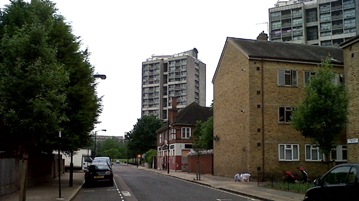Over 2,400 historic buildings given new protected status by Southwark Council
5 December 2023
Southwark Council is proud to announce that the first Local List has been adopted as part of efforts to protect the borough's heritage.
A Local List is made up of buildings or structures which are important to local people in Southwark. This importance can come from a special architectural or historic interest or from an entry having value in the local townscape or as part of a group.
Last year the council asked people what historic buildings in Southwark they valued the most. Over 2,600 contributions were received, resulting in 219 additions to the draft Local List. Now, the status of all 2,449 buildings on the Local List have been given special weight under the planning process.

Entries on the Local List are not afforded the same protection as national listing e.g. grade I or II listed. However the council now has to consider the localised merit of an entry on the Local List in any planning decisions about the site.
There will now be a general presumption against demolition. Any harm caused to a Local List entry by a proposed development would have to be justified and outweighed by the benefits created as a result of the works. This is now underpinned by Policy P26 in the Southwark Plan 2022.
Southwark’s Local List has a huge range of heritage assets, including the Old Mill in Peckham, the wooden bus shelter in East Dulwich, and the Brandon Estate in the north of the borough.
Cllr Helen Dennis, Cabinet Member for New Homes & Sustainable Development, said: “This is a huge win for Southwark’s rich heritage and one we’ve long been working towards. The epic response from local people reflects just how deep our shared desire is to protect the buildings that belong to Southwark's unique history and character. The Local List covers all four corners of the borough in all its diversity; from old pubs, former factories and schools, to residential homes and estate tower blocks.
“The Local List makes sure we take extra special care in any decisions over the future of our heritage assets. It gives the council teeth in resisting demolition of these buildings. The aim of the Local List is that entries continue to enrich our lives and townscapes for generations to come. Now approved, I'm excited to see the Local List's positive impact on decisions about sustainable development across the borough.”
The Local List and any proposed additions will be reviewed on an annual basis.
The Old Mill in Peckham
The Old Mill building received the highest number of nominations from local people with 153. It was built in the 1870s to manufacture British wine. The large building has a striking presence in its surroundings, with red brickwork often used in Victorian industrial architecture. Community Outreach Ministries restored the building to use as their church and for other community events. Comments from the public included:
“The building is very noticeable and attractive in that locality and is part of the Victorian development when the railways came. Overall it adds character as well as historic links for that area to the east of Rye Lane. The building has had almost continual use as a place of employment changing over the decades reflecting the changing nature of Peckham’s economy.”
“This building adds to the richness and character of Copeland Road.”
“The Old Mill building is large and robust, with a handsome, plain exterior in stock brick, and tiled roof with unusual semi-hipped gables to west and east ends. Against the industrial massing of the building, there are restrained elements of decoration to the exterior elevations.”
South Croxted Road wooden bus shelter in East Dulwich
The wooden bus shelter was well supported with over 70 nominations. Comments from the public included:
“The lovely wooden bus shelter only exists as a local resident gave up their garden to support the wider schools and housing expansion in this area. There used to be two matching wooden shelters here, and this one survives. There are now only handful of original wooden bus shelters in South London, and this maybe the only one in Southwark. The local community and Dulwich Society secured funding to maintain in 2015. It has local plaque installed to explain its local history.”
The Brandon Estate in Walworth
The Brandon Estate and surrounding green landscape were nominated by local people. It was built in 1958 by the London County Council, which used to cover what is known today as Inner London. The estate was purposefully built as a mix of lower buildings, a new square, the renewal of some Victorian terraces, and six 18-storey towers – the tallest in London at the time. Comments on why the Brandon Estate deserved nomination included:
“Compact and well-designed plans which mean that each flat in the tower has elongated balcony provision with great views and access to outdoor space.”
“Landmark towers – the design of the sculptural butterfly roof is an obvious landmark, with the left-over spaces being used to create four bedsits on the top of each of the six buildings.”
“Public art used to bring a sense of place – sculpture by Henry Moore, the Wooley mammoth and other mosaic pieces on external walls including the Jack Hobbs Centre.”
“The provision of pedestrian friendly spaces across the estate was included within the original aims of the design. The green spaces continue to be used successfully by the community for gardening and growing as well as sports activities. The design and design vision for these buildings and the community they service needs to be celebrated, protected and enhanced.”
The Local List got approval from the council’s Cabinet on Tuesday 5 November, subject to call-in.
Page last updated: 05 December 2023
